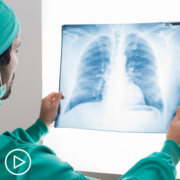How Do You Break Down Lung Cancer Diagnosis to New Patients?
How Do You Break Down Lung Cancer Diagnosis to New Patients? from Patient Empowerment Network on Vimeo.
How might a lung cancer diagnosis be explained to new patients? Expert Dr. Lecia Sequist from Massachusetts General Hospital shares how she breaks down the the tests involved in non-small cell lung cancer (NSCLC) diagnosis and treatment, advice to patients, and best practices she’s learned in communicating information to patients.
Dr. Sequist is program director of Cancer Early Detection & Diagnostics at Massachusetts General Hospital and also The Landry Family Professor of Medicine at Harvard Medical School.
[ACT]IVATION TIP:
“We know that not all patients are offered genetic testing. And if you have a diagnosis of non-small cell lung cancer, or especially the most common subtype of that called adenocarcinoma, genetic testing is most likely an important part of figuring out your treatment. So be sure to ask your doctor if that’s been done and if it hasn’t, should it be done.”
Download Resource Guide en español
See More from [ACT]IVATED NSCLC
Related Resources:
Transcript:
Lisa Hatfield:
Dr. Sequist, you have a new patient coming into your office just diagnosed with non-small cell lung cancer. How do you explain to that patient? I’m sure they’re wide-eyed and fearful and afraid. How do you explain to the layperson what that is and then the subsequent treatment that they might be experiencing in the coming months with a new diagnosis?
Dr. Lecia Sequist:
Yeah, this is a very confusing time for most patients because they’re trying to wrap their head around what’s going on. They’re usually being fed information at such a rate. It’s like drinking from a fire hose, and it’s hard to take it all in. On top of that, they may not be feeling well physically. So I think it is important to repeat things, to pause a lot, to ask if there are questions, and to give people an opportunity to get back in touch with you with questions later, because, of course, it’s happened to all of us. As soon as we walk out of the doctor’s office, that’s when the question pops into our brain. But non-small cell lung cancer, it’s a very common cancer. And it basically is a type of cancer that starts in the lung, but it can spread to other parts of the body.
And some of the most important pieces of information that your doctor will need to help figure out a treatment plan along with you is to get a biopsy to confirm that the diagnosis is what they think it is. And that is usually an invasive procedure where a small piece of the cancer is removed from the body so that you can look at it under the microscope, and they can confirm that it’s that type of lung cancer. And then probably a series of scans or radiology tests where they’re looking at different parts of the body, maybe with different lenses such as a CAT scan or a PET scan or an MRI. Those are just different types of radiology exams to see if the cancer might have spread to any of the different places.
And for lung cancer, we usually try to look head to toe, essentially look at the whole body and get a complete picture of what’s going on. And the third important thing that doctors will need to come up with a treatment plan is to do something called genetic testing. This can be confusing for people because we’re not looking at their family. We’re not looking for genes that could have come from their parents or have been passed on to their children. We’re really looking at the genes of the cancer. And together looking at the biopsy, the genes that are activated within the cancer, if any, and where the cancer might be in the body, that helps the doctors put together a treatment plan of how to attack the cancer.
Lisa Hatfield:
Great. Thank you. Do you have any tips specifically for patients when they’re first diagnosed?
Dr. Lecia Sequist:
Yeah. My activation tip for someone with newly diagnosed lung cancer would be to make sure that they’re asking their doctor if genetic testing should be done on their cancer. We know that not all patients are offered genetic testing. And if you have a diagnosis of non-small cell lung cancer, or especially the most common subtype of that called adenocarcinoma, genetic testing is most likely an important part of figuring out your treatment. So be sure to ask your doctor if that’s been done and if it hasn’t, should it be done.
Share Your Feedback:
Create your own user feedback survey






